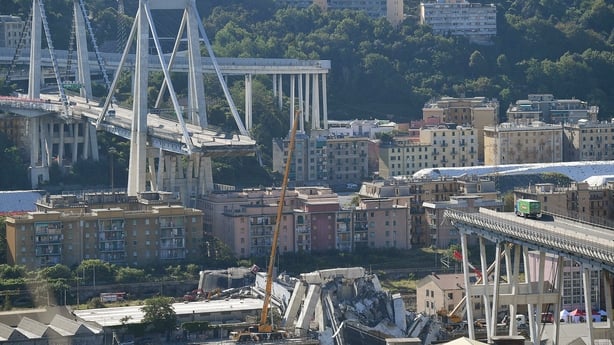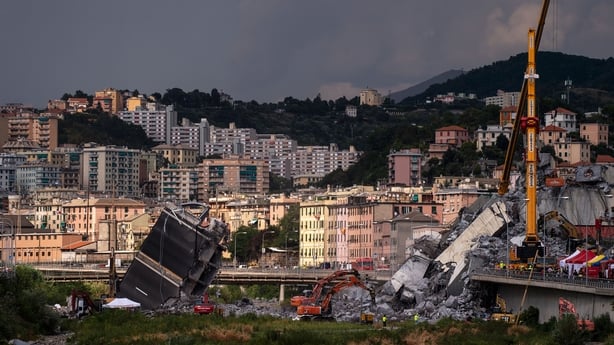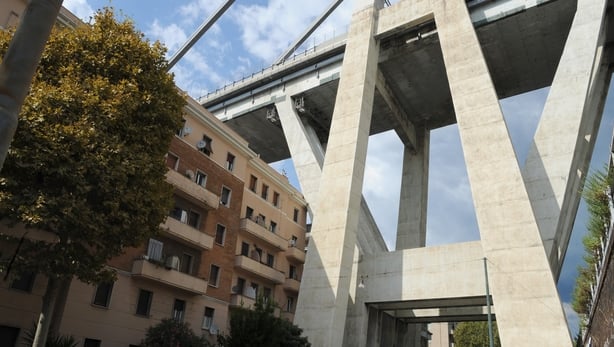Italian rescue workers used jackhammers and cranes to lift giant slabs of concrete from the Genoa highway bridge collapse, hoping to find survivors buried in the rubble of the disaster that killed at least 38 people.
A fire among the rubble held up part of the operation, sending clouds of white smoke up before being extinguished.
A spark from metal cutting equipment was thought to have caused the blaze that started in a warehouse under the ruined bridge.
A state funeral for most of the victims is due to be held tomorrow morning at the port city's Exhibition and Trade Centre, led by Genoa's archbishop, Cardinal Angelo Bagnasco, and attended by President Sergio Mattarella and Prime Minister Giuseppe Conte.
But some families have said they will boycott the event and hold their own private services, as a sign of protest against what they say was negligence that caused the bridge to collapse.
The government has declared tomorrow a national day of mourning.
Italy's government intensified its attacks on the viaduct operator amid rising anger over the tragedy and the structural problems that have dogged the decades-old Morandi bridge.
It collapsed without warning on Tuesday, sending about 35 cars and several trucks, along with huge chunks of concrete, about 45 metres onto railway tracks below.

The chance of finding survivors at this stage is slim and the unstable mountains of debris are making the search operation dangerous, but rescue workers said they have not given up hope.
"We are trying to find pockets in the rubble where people could be - alive or not," fire official Emanuele Gissi said.
Genoa's chief prosecutor has said that between ten and 20 people could still be missing under the huge piles of concrete.
Cranes and bulldozers are working to help clear the site as rescuers try to cut up and remove the biggest slabs of concrete.

Read More:
Homeless and traumatised: The other victims
Genoa bridge collapse 'a tragedy waiting to happen'
State of emergency declared after Italy bridge collapse
"We will then send in dogs and rescue workers to see if we can find any signs of life," Mr Gissi added.
The government has accused infrastructure giant Autostrade per L'Italia of failing to invest in sufficient maintenance - a claim the company denies - and said it would seek to revoke its lucrative contracts.
Interior Minister Matteo Salvini demanded that the company offer up to €500m to help families and local government deal with the aftermath of the disaster.
"If we've put up €5m, they should offer €500m," he told reporters.
"There needs to be an immediate, concrete and tangible signal for these families: they should put their hands on their hearts and in their wallets."
The collapse has prompted fears over other ageing infrastructure in Italy and abroad.
The dead include children aged eight, 12 and 13, according to Mr Salvini, while three Chileans and four French nationals are among those killed.
Sixteen people were injured.
Yesterday the first residents of some buildings in the affected area were allowed to return home, though others are too badly damaged to save.

Genoa's Morandi viaduct was completed in 1967 and has been riddled with structural problems for decades, leading to expensive maintenance and severe criticism from engineering experts.
Its collapse prompted the government to announce a year-long state of emergency in the region.
The government, in power since June, has pinned the blame on Autostrade, which operates and maintains nearly half of Italy's motorways.
Autostrade, which estimates it will take five months to rebuild the bridge, denies scrimping on motorway maintenance, saying it has invested over €1bn a year in "safety, maintenance and strengthening of the network" since 2012.
With pressure mounting, it released a statement yesterday saying ambulances would be able to travel on its roads toll-free from now on to "further enable the precious rescue and aid operations".
More than 600 people were evacuated from around a dozen apartments beneath the remaining shard of bridge.
Mr Salvini has said the buildings would have to be pulled down.
Engineering study in 2017 warned about Italy bridge stability - reports
An engineering study commissioned by Italian highway operator Autostrade last year warned about the state of the concrete-encased cable stays that held up abridge that collapsed this week in Genoa, two Italian newspapers reported today.
Autostrade per l'Italia, controlled by infrastructure group Atlantia, manages the section of the A10 motorway linking the French border to Genoa.
The bridge had presented problems since soon after it was completed in 1967 and some of the stays were reinforced as early as the 1990s, experts have said.
Atlantia had no immediate comment on the reports in La Stampa and Repubblica newspapers, which cited a study by engineers at Milan's Politecnico university in November 2017.
Autostrade has said it monitored the bridge on a quarterly basis as required by law and that it had carried out additional checks by hiring external experts.
The newspaper reports said the university study had found that the stays of the section of the bridge that later collapsed reacted to vibration "in a way that does not entirely conform with expectations and requires further investigation."
The study said the anomaly in the stays' reaction may have been linked to corrosion of metal in some cables.
One of the peculiarities of the bridge was that its cables were wrapped in concrete, making it hard to assess their state.
The newspapers said the company announced a €20m tender in May this year as it planned to strengthen the stays that had not been reinforced in the 1990s.

